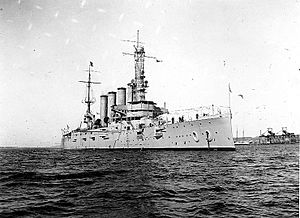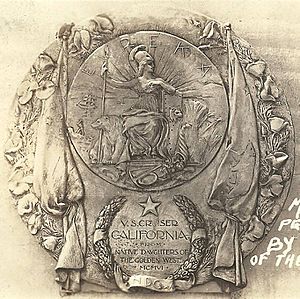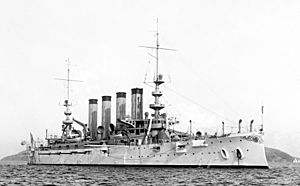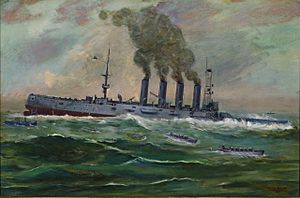USS California (ACR-6) facts for kids

USS San Diego (ACR-6), 28 January 1915, while serving as flagship of the Pacific Fleet. Note two-star Rear Admiral's flag flying from her mainmast top.
|
|
Quick facts for kids History |
|
|---|---|
| Name |
|
| Namesake |
|
| Ordered | 3 March 1899 |
| Awarded | 10 January 1901 |
| Builder | Union Iron Works, San Francisco, California |
| Cost | $3,800,000 (contract price of hull and machinery) |
| Laid down | 7 May 1902 |
| Launched | 28 April 1904 |
| Sponsored by | Miss F. Pardee |
| Commissioned | 1 August 1907 |
| Renamed | San Diego, 1 September 1914 |
| Identification | Hull symbol: ACR-6 |
| Fate | sunk 19 July 1918, by U-156 |
| General characteristics | |
| Class and type | Pennsylvania-class armored cruiser |
| Displacement |
|
| Length |
|
| Beam | 69 ft 6 in (21.18 m) |
| Draft | 24 ft 1 in (7.34 m) (mean) |
| Installed power |
|
| Propulsion |
|
| Speed |
|
| Complement | 80 officers 745 enlisted 64 Marines |
| Armament |
|
| Armor |
|
| General characteristics (Pre-1911 Refit) | |
| Installed power | 8 × Modified Niclausse boilers, 12 × Babcock & Wilcox boilers |
| Armament |
|
|
USS SAN DIEGO (Armored Cruiser) Shipwreck Site
|
|
| Lua error in Module:Location_map at line 420: attempt to index field 'wikibase' (a nil value). | |
| Nearest city | Fire Island, New York |
| Area | 27 acres (11 ha) |
| Built | 1918 |
| Built by | Union Iron Works |
| NRHP reference No. | 98000071 |
| Added to NRHP | 17 February 1998 |
The second USS California (ACR-6) was a powerful United States Navy ship. It was an armored cruiser from the Pennsylvania class. This ship was later renamed San Diego.
It was built by Union Iron Works in San Francisco, California. The ship was launched on April 28, 1904. Miss Florence Pardee, whose father was the governor of California, helped launch the ship. The California officially joined the Navy on August 1, 1907.
Contents
A Ship's Journey: Early Years
Serving the Pacific Fleet
The California joined the Pacific Fleet in 1908. It took part in a special naval event in San Francisco. For several years, the cruiser trained and practiced along the west coast. This helped its crew stay ready for anything.
In 1909, the ship sailed to Hawaii and Samoa. Then, in December 1911, it went to Honolulu. In March 1912, it continued its journey to serve in Asia. After showing American strength in the Far East, it returned home in August 1912.
Protecting American Interests
The California was then sent to Corinto, Nicaragua. There was political trouble in Nicaragua at the time. The ship helped protect American citizens and their property.
After this, it went back to operating along the west coast. It kept a close watch on Mexico, which was also having political problems. During this time, two of its crew members were sadly killed in an incident in Mexico.

On September 1, 1914, the ship's name was changed to San Diego. This was done so that a new battleship, the USS California, could use the original name. The San Diego became the main ship for the Commander-in-Chief of the Pacific Fleet.
In January 1915, a boiler on the ship exploded. This caused the ship to go into a shipyard for repairs. Two brave crew members, Ensign Robert Cary and Fireman Second Class Telesforo Trinidad, earned the Medal of Honor for their heroic actions during the explosion. After repairs, the San Diego was a popular sight at the Panama–California Exposition. It continued to serve as a flagship until February 1917, when it was put into reserve.
World War I Service
When World War I began, the San Diego was fully ready for duty on April 7. It served as the flagship for the Commander, Patrol Force, in the Pacific Fleet. On July 18, it was ordered to join the Atlantic Fleet.
The San Diego arrived in Virginia on August 4. It joined Cruiser Division 2. Its main job was to protect groups of ships, called convoys, as they started their journey to Europe. These convoys faced dangerous submarines and rough weather in the North Atlantic. The San Diego successfully escorted all its assigned ships safely.
The Sinking of the San Diego
On July 18, 1918, the San Diego left the Portsmouth Naval Shipyard. It was heading to New York to meet and escort another convoy to France. The ship's captain, Harley H. Christy, ordered the ship to move in a zigzag pattern. This was a way to make it harder for submarines to hit them.
The next day, July 19, at 11:05 AM, an explosion happened on the left side of the ship. It was near the engine room and below the water. Water quickly rushed into the ship. Captain Christy thought they had been hit by a torpedo. He ordered the ship's guns to fire at anything that looked like a submarine. He also tried to make the ship go full speed and turn, but the engines were damaged.
The ship began to tilt to one side. Water started pouring in through a gun port, flooding the deck. The ship's radio was not working. Captain Christy sent an officer to shore in a boat to get help.
About 10 minutes after the explosion, the San Diego began to sink quickly. Captain Christy gave the order to lower the life rafts and boats. He waited until he was sure the ship was going to capsize before telling the crew to leave. The crew left the ship in an organized way.
The San Diego sank in just 28 minutes. Sadly, six lives were lost. This was the only major warship the United States lost during World War I. Two men died instantly from the explosion. One crewman was never seen again. Another was killed when a smokestack broke loose as the ship turned over. One man died when a life raft fell on him. The sixth man was trapped and drowned.
Meanwhile, the officer sent for help reached shore. Rescue vessels were immediately sent to the scene.
What Caused the Sinking?
After the sinking, Captain Christy believed a torpedo had hit the San Diego. However, no submarine was seen, and no torpedo trail was spotted. Some thought it might have hit a mine, even though mines usually hit the front of a ship. Other experienced sailors believed a mine was the cause because of how violent the explosion was and how fast the ship sank.
In August 1918, a Navy investigation concluded that a mine had sunk the San Diego. They noted that six contact mines were found in the area where the ship sank.
In 1999, a new idea came up that a German spy might have planted explosives on the ship. However, the Naval Historical Center disagreed with this idea.
In July 2018, the U.S. Navy News Service stated that the exact cause of the sinking was still unknown. But, after World War I, German naval records showed that the German submarine U-156 had placed mines off the coast of New York. This led many to believe that U-156 was responsible for the sinking of the San Diego.
In December 2018, Navy archaeologist Alexis Catsambis said, "We believe that U-156 sunk San Diego." Studies of the flooding patterns and the hole in the ship did not match an internal explosion or a torpedo hit. Mines were designed to hit the lower, less protected parts of warships. Researchers believe a mine hit an area of the hull that was only about half an inch thick.
The Wreck Today
The wreck of the San Diego lies about 110 ft (34 m) underwater. Its highest parts are about 66 ft (20 m) below the surface. This makes it a very popular spot for scuba diving in the U.S.
The ship lies upside-down and has changed a lot over the last 100 years. More divers have died exploring the wreck than the number of crew members who died when it sank. But this has not stopped its popularity. Divers call it the "Lobster Hotel" because so many lobsters live there. It is also home to many kinds of fish. The wreck is located about 13.5 mi (21.7 km) south of Patchogue, New York.
The wreck is listed on the National Register of Historic Places. This means it is an important historical site.
Legacy
In 2015, a special print was made by the Bureau of Engraving and Printing. This print was first created in 1915.
Images for kids
-
This plaque, showing the Great Seal of the State of California, was given to the USS California in 1907.







